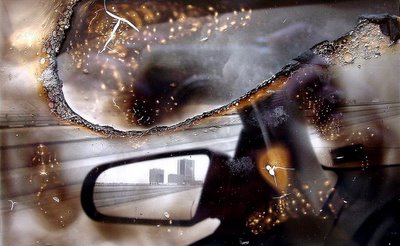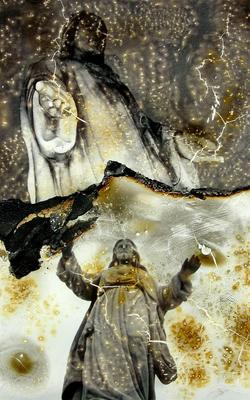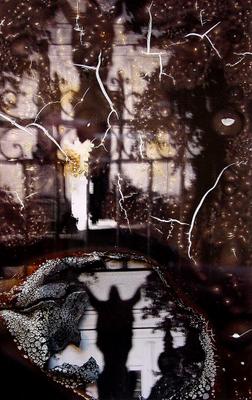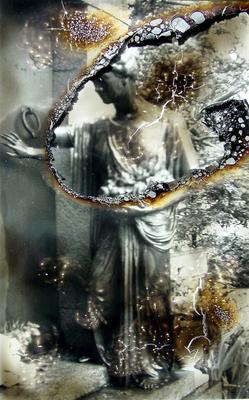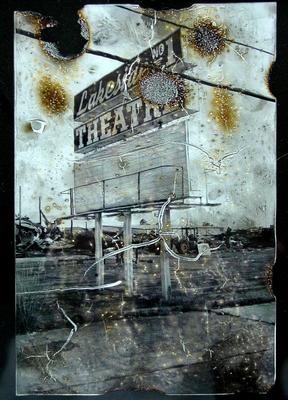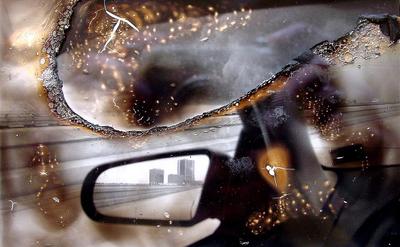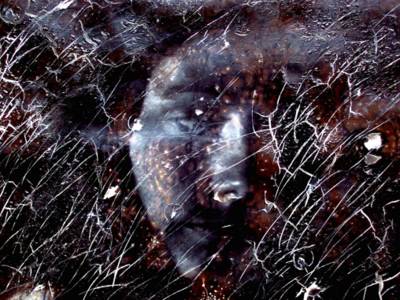Burnversions Included In Louis Jacobson's (Art Critic for the Washington City Paper) Top List Of 2005 Photography Exhibitions
Mr. Louis Jacobson, art critic for the Washington City Paper, has issued his top photography exhibition picks for 2005. I am extremely grateful to him for including my exhibition, Burnversions.
---
Gimme the Curation
by Louis Jacobson
I tried. I really did. But I simply couldn’t find enough worthy photography exhibitions from 2005 to fill up a top-10 list. So I’m going with nine—and compared to the bounty of choices from past years, even that’s pushing it.
To be fair, 2005 wasn’t a truly awful one for photography in Washington. But it was significantly flawed by missed opportunities. Consider this summer’s Irving Penn retrospective at the National Gallery of Art. It was full of gorgeous platinum prints that documented everything from fashion models and New Guinean warriors to cigarette butts. But the exhibition was also stocked with redundant, uninteresting collages and other lesser works—pieces that would have been culled if the museum had been willing to question the biases of the artist, who made a major bequest of works to the National Gallery in 2002.
The Library of Congress’ exhibition of long-lost color photographs from the Great Depression similarly suffered from lazy curation. The unexpectedness of seeing the Depression depicted in color carried the show only so far; viewers would have been more enlightened had organizers provided more background information—for example, about how the photographers grappled with the complicated transition from black-and-white to color film. Ditto for the National Academy of Sciences’ exhibition of post-1970 depictions of the Western landscape. The show was stocked with fine pieces, including bracing images by Robert Dawson, Patrick Nagatani, and Mark Ruwedel. But the enterprise was hobbled by the curators’ incorrect assumption that photographers in the West invariably sought to document the beautiful prior to the late 20th century. As a result, what could have been a fascinating examination of photographic history was reduced to a presentation of photographic novelty.
There is at least some good news to report about local museum exhibitions: Heightened attention to photography at the National Gallery has brought several shows that Washingtonians might not have otherwise seen, including an upcoming exhibition on the restless, inventive first 100 years of photographic history. And better yet—at least if the latest timetable is to be believed—the renovation of the Smithsonian American Art Museum and the National Portrait Gallery is to be completed by July 4, 2006, reinstating two crucial local photography venues.
As usual, smaller commercial galleries bore most of the burden of bringing new photography to Washington in 2005. Too bad local artists weren’t as busy: This year, the few standouts included Julee Holcombe, whose exhibition at Conner Contemporary Art showcased her inspired Old Masters–go–digital style; Jason Falchook, whose contribution to Fusebox’s “Landscaping” show displayed a welcome maturation in his work; and James W. Bailey and Noelle Tan (see below).
Here’s hoping for a better year in 2006. Until then, here’s one critic’s list of the top local photography shows of 2005—all nine of them:
1. “André Kertész” at the National Gallery of Art This was easily the best of the big retrospectives of 2005, not only for the quality of the artist’s work—which remains cutting-edge even decades after the fact—but also for the curators’ decision to organize the thing more or less chronologically. This bit of traditionalism paid off: Seeing Kertesz’s style develop over time enabled visitors to sense the ebbs and flows of the photographer’s professional and personal fortunes, creating a long and engaging narrative arc not entirely separate from the subject matter he photographed.
2. “Burnversions” at the Reston Community Center As subject matter goes, cemetery statuary, vintage signs, and views from moving cars are perfectly adequate. But the violent processes James W. Bailey uses on his film and prints makes them seem extraordinary. Influenced by memories of fire-damaged photographs he saw as a child, Bailey heats, pricks, and slashes his materials, creating phantasmagorical results that lend themselves to extended visual exploration.
3. “Gina Brocker: Photographs From the Series ‘The Donovans and Other Settled Travellers’ ” at Irvine Contemporary This selection of 11 images stemmed from Brocker’s monthslong stay with a group of Irish Travellers settled forcibly by the government. Under dreary, overcast skies, a large extended family hovers between joy and violence, between mobility and stasis. Compelling even in this small sampling, the project presents hard truths painted in soft color.
4. “Shomei Tomatsu: Skin of the Nation” at the Corcoran Gallery of Art Tomatsu, little known in the United States, is one of Japan’s photographic giants—and for good reason. In his five-decade career, Tomatsu has documented an astonishingly wide array of subjects in both black-and-white and color, including relics of Japan’s traditional past, tensions between Okinawans and the U.S. military, protests and sexual experimentation of the ’60s, and, most famously and achingly, the scars of atomic-bomb survivors. The show’s sweep was mesmerizing, undercut only by a needlessly complicated organizational scheme.
5. “Noelle Tan: Latent” at the District of Columbia Arts Center Tan, a 30-something Washingtonian, creates photographs dominated by either white or black space, confining her subjects to a small area limned in charcoal gray. Whether portraying dogs, light poles, or picnic tables, Tan’s work invites us into an isolated, miniature universe that’s moody, mysterious, and unlike anything created by her contemporaries.
6. “Lida Moser: 50 Years of Photographs” at Fraser Gallery Bethesda Now in her 80s and living in the Washington area, Moser had a distinguished but underappreciated career as a black-and-white documentarian. As this 23-piece show demonstrated, she had a special knack for photographing architecture, turning skyscrapers into abstract-expressionist stripe paintings and office lobbies into alien no-places. But she was equally adept at capturing people, from expectant Scottish paradegoers to jazzman Charles Mingus, whose energy, in her interpretation, positively surrounded him.
7. “Reflections of France” at the Kathleen Ewing Gallery Among great Parisian photographers—Kertész, Atget, Brassai, Cartier-Bresson—Willy Ronis is considered at best an also-ran. But this 46-work exhibition suggested that he merits full membership in that elite club. Yes, some of his images are overly nostalgic. But others tease multilayered narratives from found scenarios or document life’s little surrealities, such as a group of nuns in full habit walking in a straight line through an idyllic wood.
8. “Lewis and Clark Revisited: A Trail in Modern Day,” at the Department of the Interior Museum It’s only natural that an exhibition on the route taken by Lewis and Clark mounted 200 years later would highlight such long-term physical changes as the construction (and destruction) of bridges, dams, and nuclear power plants. But what was unexpectedly moving was photographer Greg MacGregor’s ability to find subjects affected by more recent events: a boulder sacred to the Mandan that was carelessly moved for a highway turnoff, a swimming pool in a “new town” constructed to house Native Americans displaced by floodwaters.
9. “Barbara Probst: Exposures” at G Fine Art Barbara Probst’s approach to fashion shoots is hardly intended to flatter her sitters: She trains multiple cameras from different angles and distances, then flips their shutters simultaneously. The result is a series of images unified by time but not by much else—the anatomical illustration of a moment.
Two artists whose local shows didn’t quite make my list deserve credit for pushing the boundaries of photography. One is the famed portrait painter Chuck Close, whose exhibition at the David Adamson Gallery included four close-up holograms of the artist’s head convincing enough to scare the bejeezus out of you. The second is the relatively unknown Lucie Duval, whose work appeared in a group show at the Canadian Embassy. Duval photographs landscapes from her native country, slices the resulting transparencies into smaller pieces, inserts them individually into mason jars, and arranges the jars into a matrix. When backlit, her pieces becomes concise, striking commentaries on the commodification of nature—a phenomenon that has been precipitated in no small part by Duval’s chosen medium. CP
